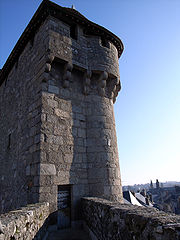
La Souterraine
Encyclopedia
La Souterraine is a commune
in the Creuse
department in the Limousin
region
in central France
.
comprising the town and a few small hamlets situated some 20 miles (32.2 km) west of Guéret
at the junction of the D1, D912, D951 and the N145 roads. The small river Sédelle, a tributary of the Creuse River
, flows through the town. It is also served by a TER railway link.
The Benaize
, a tributary of the Anglin
, has its source in the commune.
The Brame
, a tributary of the Gartempe
, has its source in the commune.
occupation here, attested by the discovery of stone age
tools and a menhir
. Remains of Roman villas and temples have been unearthed. In medieval times, a church and fortified walls were built. The name of the town, translating as ‘subterranean’, comes from the underground parts of the church, the crypt
.

Communes of France
The commune is the lowest level of administrative division in the French Republic. French communes are roughly equivalent to incorporated municipalities or villages in the United States or Gemeinden in Germany...
in the Creuse
Creuse
Creuse is a department in central France named after the Creuse River.-History:Creuse is one of the original 83 departments created during the French Revolution on 4 March 1790. It was created from the former province of La Marche....
department in the Limousin
Limousin (région)
Limousin is one of the 27 regions of France. It is composed of three départements: Corrèze, Creuse and the Haute-Vienne.Situated largely in the Massif Central, as of January 1st 2008, the Limousin comprised 740,743 inhabitants on nearly 17 000 km2, making it the second least populated region of...
region
Régions of France
France is divided into 27 administrative regions , 22 of which are in Metropolitan France, and five of which are overseas. Corsica is a territorial collectivity , but is considered a region in mainstream usage, and is even shown as such on the INSEE website...
in central France
France
The French Republic , The French Republic , The French Republic , (commonly known as France , is a unitary semi-presidential republic in Western Europe with several overseas territories and islands located on other continents and in the Indian, Pacific, and Atlantic oceans. Metropolitan France...
.
Geography
An area of farming and light industryLight industry
Light industry is usually less capital intensive than heavy industry, and is more consumer-oriented than business-oriented...
comprising the town and a few small hamlets situated some 20 miles (32.2 km) west of Guéret
Guéret
Guéret is a commune and the prefecture of the Creuse department in the Limousin region in central France.-Geography:A light industrial town, the largest in the department, with a big woodland and a little farming not far from the town centre...
at the junction of the D1, D912, D951 and the N145 roads. The small river Sédelle, a tributary of the Creuse River
Creuse River
The Creuse is a 264 km long river in western France, a tributary of the river Vienne. Its source is in the Plateau de Millevaches, a north-western extension of the Massif Central...
, flows through the town. It is also served by a TER railway link.
The Benaize
Benaize
The Benaize is a long river in the Creuse, Haute-Vienne, Vienne and Indre départements, central France. Its source is near La Souterraine. It flows generally northwest...
, a tributary of the Anglin
Anglin
The Anglin is a long river in the Creuse, Indre and Vienne départements in central France. Its source is near Azerables. It flows generally northwest...
, has its source in the commune.
The Brame
Brame
The Brame is a long river in the Creuse and Haute-Vienne départements, central France. Its source is at La Souterraine. It flows generally west...
, a tributary of the Gartempe
Gartempe
The Gartempe is a French river, 205 kilometres long. It is a left tributary of the Creuse River, which it joins in La Roche-Posay. Its source is in the municipality of Peyrabout.Among its tributaries are the Anglin, the Brame and the Semme....
, has its source in the commune.
History
There is evidence of pre-RomanAncient Rome
Ancient Rome was a thriving civilization that grew on the Italian Peninsula as early as the 8th century BC. Located along the Mediterranean Sea and centered on the city of Rome, it expanded to one of the largest empires in the ancient world....
occupation here, attested by the discovery of stone age
Stone Age
The Stone Age is a broad prehistoric period, lasting about 2.5 million years , during which humans and their predecessor species in the genus Homo, as well as the earlier partly contemporary genera Australopithecus and Paranthropus, widely used exclusively stone as their hard material in the...
tools and a menhir
Menhir
A menhir is a large upright standing stone. Menhirs may be found singly as monoliths, or as part of a group of similar stones. Their size can vary considerably; but their shape is generally uneven and squared, often tapering towards the top...
. Remains of Roman villas and temples have been unearthed. In medieval times, a church and fortified walls were built. The name of the town, translating as ‘subterranean’, comes from the underground parts of the church, the crypt
Crypt
In architecture, a crypt is a stone chamber or vault beneath the floor of a burial vault possibly containing sarcophagi, coffins or relics....
.
Population
Sights
- The church dating from the eleventh century, with its Roman crypt.
- The fifteenth-century Manorhouse de Châteaurenaud.
- The thirteenth-century gate, the Porte de St.Jean, and the rest of the ramparts.
- A feudal motte, circular tower and the castle at Bridiers.
- The eighteenth-century chapel of the hospital.
- The ancient chapel of Sainte-Eutrope.
- The fourteenth-century church at Bussière-Madeleine.


